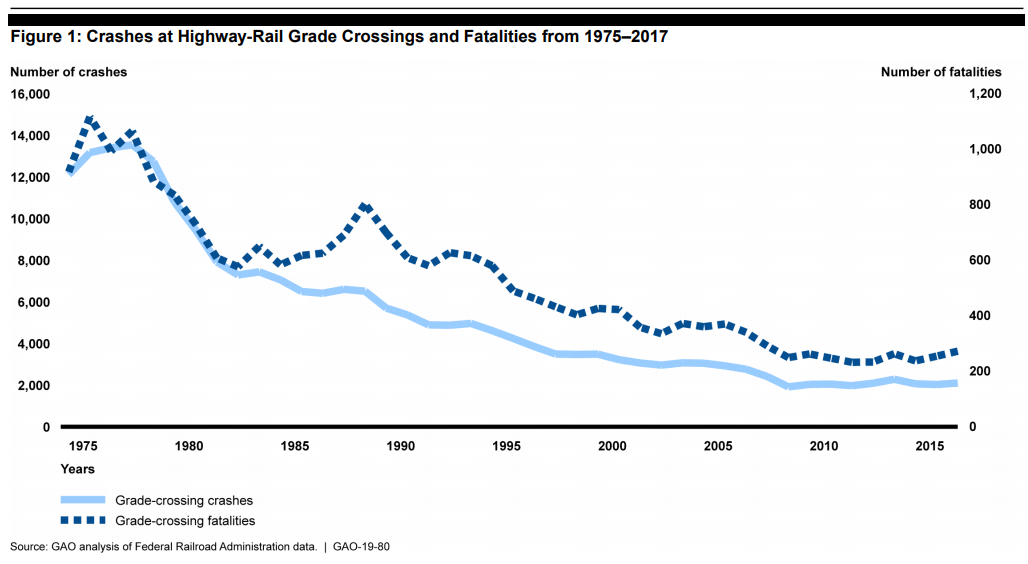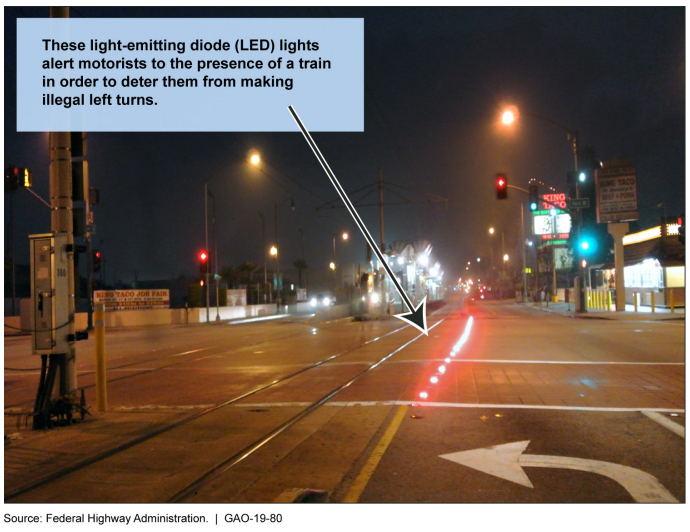Connecting state and local government leaders
How we keep people on foot and in cars from getting hit by trains hasn't changed much in the last century.
When a pedestrian walks out in front of car, many newer vehicles will automatically hit the brakes. Cars of every class come equipped with blind spot monitoring and crash prevention technology, while navigation apps can warn drivers about everything from an accident miles ahead to a nearby Chik-fil-A.
In contrast, the technology around railroad crossings remains, well, out of the railroad era. The gold standard is flashing red lights, bells and gates that lower ahead of a train’s arrival. It’s been that way since the “railroad grade crossing protection system” was patented in the 1960s—a slight upgrade from the similar warning systems from the half century prior. Pair those with an iconic railroad crossing “crossbuck” sign and you have what is supposedly the best technology available.
Unfortunately, this is not a case of “if it ain’t broke, don’t fix it.”
While deploying the standard safety infrastructure and eliminating rail crossings drastically reduced injuries and deaths for years, that is no longer the case, with fatalities more recently holding steady.
“Statistics have shown that progress has leveled off in the last five years,” Secretary of Transportation Elaine Chao told stakeholders at the Trespasser & Grade Crossing Fatality Prevention Summit last month. Since 2009, deaths from trains hitting vehicles or pedestrians at grade crossings have hovered around 250.
The issue of people in cars and on foot being hit by trains is more substantial and prevalent than most realize.
“When you see it nationally it’s somewhat astounding,” Ronald Batory, the Federal Railroad Administrator, told the crowd. “On a weekly basis, today, we have 20 to 30 incidences combined between grade crossing and trespasser incidences, that represent anywhere between 10 to 15 deaths a week.”
In total, between people who gamble to beat a train with their car or pedestrians who wander onto the tracks—some to take their own lives, others trying to cross quickly—there are about 750 deaths and around as many injuries each year.
“It’s 1,500 too many, and they’re all avoidable,” Battory said. About 95 percent of all rail-related deaths involve drivers at crossings or people walking across tracks.
How to keep people clear of passing trains is a problem as old as the railroad—and there have been attempts at creative solutions just as long. A favorite “innovation” of railroad geeks is a 1930s prototype sign that graced Grenada, Mississippi into the 1970s. It featured an air-raid siren and a neon light-illuminated sign with skull and-crossbones and the words “Stop-DEATH-Stop.”
Subtle, it was not. Innovative, maybe.
Perhaps for obvious reasons, innovation and disruption has not been a motto of the railroad industry when it comes to safety. And for the last several decades investing in what traditionally worked served them well. Federal Railroad Administration data shows deaths are down by 80 percent at grade crossings since 1980. The preference is to avoid pedestrian and automobiles crossing rail lines altogether, with a federal motto being “the safest crossing is the one that doesn’t exist.”
Efforts to eliminate crossings come at a significant cost, though. For instance, the U.S. Department of Transportation announced $132 million in grants to begin to untangle a jumble of streets with eight separate rail lines in Chicago last month. Those funds will be combined with over $200 million in other public sector funds to pay for the first phase of the project. With the crossings creating 10,000 hours of motorist delay annually—not to mention slowing trains through our entire national rail system—the investment will likely have significant payoff.
Due to the expense of these projects, few are completed every year. In 2016, only 3 percent of the projects funded were grade separation projects, according a recent report from the Government Accountability Office.
As funding or local political will for a major infrastructure project is often not in the cards, paying for traditional technology has been the other strategy: more lights, gates and other traditional barriers. Still, they aren’t at every crossing. Just over half of rail crossings have warning systems, and only about one third of those have gates.
Ultimately, this strategy seems to have closed in on the limits of diminishing returns over the last decade. It’s not as if the technology is failing; however, it’s ability to stop individuals may be. According to Chao, only 32 of the more than 2,100 grade crossing collisions last year involved a failure of automatic warning devices. Yet over 60 percent of crashes occur at crossings with warning systems.

It’s difficult to believe not one urban planner, engineer or technologist has thought of a better way to deal with rail crossings in the last half century. The recent GAO report suggests potential innovation in the space may be held back by the codification of what projects the federal government will pay for to improve railroad crossing safety.
Currently, states can only use federal grant funds for safety technologies in the Federal Highway Administration’s “Manual on Uniform Traffic Control Devices.” GAO recommended DOT provide more flexibility in these grants to encourage innovation. FRA has previously worked with states and localities on ideas like photo enforcement at rail crossings and new road markings to alert drivers, such as LEDs embedded in pavement, but the ideas have not caught on and little of the next-generation technology we see elsewhere has been dedicated to the space.

“We need to inject more technology… with risk elimination at the forefront,” Batory said. “Technology will move faster than the ink can be applied or dry. And if we don’t unleash technology, it will pass us up.”
Over the past few years, federal transportation leaders have attempted to make inroads with technology companies in an effort to encourage them to better equip navigation apps with information and rail crossing warnings for users. But there is little to show for it to date.
Back in 2016, the National Transportation Safety Board asked companies to add the 200,000-plus grade crossings in the nation to their apps, and to provide alerts to drivers using the applications. Despite a much-touted partnership between FRA and Google at the time, it is not clear that any major GPS or navigation application has implemented the NTSB recommendation.
According to an FRA spokesperson, the agency is making another push to work with the navigation industry in an effort to “explore integrating highway-rail grade crossings into their products and services to improve safety at crossings.” Google, TomTom, Waze, and Here were all present at last month’s summit. The spokesperson also told Route Fifty Google has “expressed renewed interest” in collaboration, and the FRA is sharing data and discussing collaboration with other companies to improve crossing safety and awareness.
DOT is working to pilot technology that will allow for vehicle-to-infrastructure or vehicle-to-train communication. However, DOT officials told the GAO there is no timeline for automakers to adopt these technologies, which “will likely make this a long-term effort.” To date, the two have spent $1.9 million on these endeavors, with $514,000 allocated for fiscal year 2019.
“The goal is to keep grade crossing safety part of the ongoing conversation about the development of intelligent or autonomous vehicles,” Batory said. “How should cars, buses and tracks communicate with grade crossings? How can this be used to make grade crossings safer and prevent drivers from violating the cross warnings?”
The United States isn’t the only nation working on the problem. In 2013, Queensland, Australia began testing short range communications technologies that enable approaching trains to send road vehicles within one kilometer “six levels of in-car audio visual alerts that escalate in urgency and volume as trains approach.”
While the rail industry and international transportation officials have high hopes for automated vehicles to reduce deaths through intelligent transportation systems that take the decisions around rail crossings out of the hands of human drivers altogether, full automation is not right around the corner, according to experts.
In the near-term, it’s less clear why more has not been done to incorporate rail crossing alert warnings into existing navigational devices. If navigation apps can alert drivers to entering a highway or a new state, or ask pedestrians if they just entered a Starbucks, it is unclear why these same apps cannot remind drivers and pedestrians to be cautious when approaching a train crossing.
According to Ted Greener, Director of Public Affairs for the American Association of Railroads, the rail industry has shared its maps with those in the navigation industry. Google was not able to provide additional information to Route Fifty on the status of their collaboration with railroad authorities.
One thing is clear: to reduce deaths, the onus is on finding ways to stop automobiles, their drivers and pedestrians—not trains. A full speed train can take a mile or more to stop after an emergency brake is applied.
“The saying, 'You can’t stop a freight train,' is real,” Greener said.
Mitch Herckis is Senior Editor and Director of Strategic Initiatives for Route Fifty.

NEXT STORY: Surveying the Public in a City Being Used as Federal Drone Testing Site




